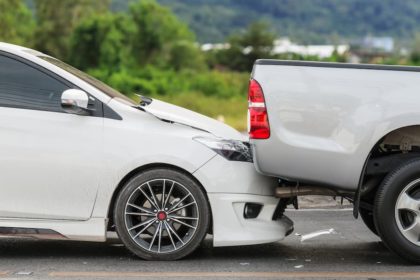Nobody ever wants to get into a car accident, but perhaps one of the most terrifying car accident experiences is the rear-end collision. A rear-end collision happens when two vehicles collide, with the vehicle in the front being struck while stationary or by a vehicle behind traveling at higher speeds.
Many safety features in automobiles have been built to accommodate side impacts, head-on collisions, and other impacts. Still, surprisingly enough, the anticipation of rear-end impacts make up for a lot fewer safety features.
You almost never see a rear-end collision happening; if you do, it is too late to do anything about it. Many of these accidents happen for various reasons, such as the driver in the rear not paying attention, being distracted, traveling too fast, driving while intoxicated, or not compensating for road conditions such as ice or other slick surfaces. Missouri law may initially blame the driver in the rear for the accident.
Who Is to Blame?

The rear driver is typically at fault, and many states use a hammer and nail analogy to explain why. It can be argued that hitting a nail with a hammer is not the fault of the nail because the hammer is the one that is moving, and the nail cannot get out of the way. The nail does not choose to be struck, and the hammer causes the impact.
The same logic applies to a rear-end collision, especially if the driver who struck the vehicle in the front was not paying attention, was driving too fast, or was not being mindful of the road conditions leading to the accident. Defensive driving can help you only so much, and if rear-ended, your options to evade the collision are limited by many factors.
Types of Accidents
The results can be severe when two vehicles are involved in an accident.
Car-on car accidents are just one way that a rear-end collision can happen, each with varying severity.
- Car accidents: Very common with rear-end accidents, car vs. car accidents are common on highways during rush hour, start and stop traffic in urban areas, parking lots, and any time vehicles come to abrupt stops or change their speeds. Since cars are reasonably well-protected, injuries can be severe—though they are usually less intense than other vehicular collisions.
- Motorcycles: Anytime a vehicle collides with a motorcycle, the injuries and damage can be severe. Due to weight, motorcycles have the unique ability to accelerate and decelerate quicker than other types of vehicles. On busy roads or with drivers not paying attention, drivers often stop short or change lanes, and motorcycles can impact them from behind, with devastating results. Motorcycles struck from behind are at a severe disadvantage to weight and force, often with some very traumatic injuries resulting from the crash.
- Truck accidents: Like car vs. motorcycle accidents, weight and force factor in truck vs. car or motorcycle wrecks. Trucks take a lot longer to slow down and come to a complete stop than cars, and drivers should be extra aware of road conditions and traffic to prevent this. An 80,000 pound truck hauling a load can cut through a passenger car like nothing in a rear-end collision. The results are nearly always going to be catastrophic.
- Bike accidents: Bicyclists are incredibly vulnerable. Like motorcycles, they lack the protection of safety features such as airbags and seatbelts, but are also traveling at much slower rates of speed than other vehicles. The force of the impact can be life-threatening, at the very least.
Types of Injuries
Rear-end collisions result in different injuries than other car accidents. Even if you have been hit in a rear-end accident, the results may be dire.
See a medical professional, even if you do not feel like your injuries are severe, because you may have sustained:
- Whiplash: One of the most common—and very serious—injuries resulting from a rear-end collision. Whiplash happens when the force of the impact from behind causes the head to shift suddenly on your neck, shifting backward at first and then forward with the rest of the impact—like the motion a whip makes when it cracks. This injury can not only cause concussion and other Traumatic Brain Injuries from bruising the brain inside the skull, but it can also break the neck, cause nerve damage in your spinal column, and even cause muscle and ligament damage to your bones and tissues that help support your head.
- TBIs: The more we learn about Traumatic Brain Injuries, the more we understand how long-lasting the damage can be. Impacts from rear-end collisions have been known to shear blood vessels and arteries, flood the brain with blood and other fluid, and create a stacking type of damage due to the pressure exerted on the brain from inside the skull. Without medical treatment, these injuries can quickly lead to permanent cognitive damage or even death.
- Broken bones: Any vehicle impact can leave you vulnerable to breaking bones due to the sudden impact and the forces exerted on your body through the collision of two heavy moving bodies of metal, glass, and rubber. Broken bones can result from striking surfaces such as the car’s dash, windows, and other surfaces. Sometimes you can break a bone just from the force of the impact.
- Lacerations: Cuts from twisted metal and shattered glass are common in a rear-impact accident. Most commonly, the rear window can shatter, sending tiny projectiles of glass flying through the inside of the car at high speeds.
- Soft-tissue damage: Ruptured organs and other soft tissues are common with car collisions. Often these injuries are not so obvious and may present as bruising, blood in urine or feces, and strange pains after the accident. The impact on soft tissue can result in the loss of those organs.
- Burns: This type of accident can happen in various ways—from the burns sustained from the propellants used in deploying airbags to hot fluid from ruptured radiators entering the car from the vehicle that had struck yours from behind. Impacts have been known to puncture fuel tanks and even cause fires, which can quickly spread through your car.
- Death: Any number of the above injuries can cause death, either instantaneously or through a drawn-out process that medical assistance might prevent through immediate action.
Recovery and Rehabilitation
A rear-end accident might be a minor event, especially at lower speeds, with everything going right with safety features deploying and conditions being optimal for survival.
As the injuries compound and get worse, the severity of these injuries will require more extensive care.
- Hospitalization: Any rear-end accident may require a trip to the emergency room, even if it is just to run some tests. More severe injuries will require hospitalization, which is expensive, often painful, and time-consuming. Your recovery could take a few days to several weeks.
- Surgery: Breaks, organ damage, and other traumatic injuries may require surgery to save the life or limb of the person who has been injured. Surgery is expensive and may result in a life-changing event that the victim must learn to work around as they heal, if not permanently.
- Rehabilitation: Surgery and extensive treatment may require physical therapy, mental health assessments and treatments due to PTSD, permanent disabilities that require vocational rehabilitation and training, or cognitive rehabilitation to overcome the lasting effects of the trauma.
- Lost time at work: If you have been injured in a car accident, you are likely to miss work, which can cause financial strain on you and your family. Lost time from work may even result in losing your job over time and potentially threaten your insurance benefits outside of what is covered by car insurance.
- Disability: Many people never recover from the results of a car accident, and one of the things you will need to contend with for the rest of your life is learning how to function again with a disability. This experience can be challenging, lead to depression, and impact the quality of your life.
What to Do in Case of an Accident
If you have are in a rear-end collision:
- Get to safety: Using your discretion and, if possible, move your vehicle out of danger, but pull off the road. If you are injured or your vehicle cannot move, use your judgment on where you will be safer, either staying in your vehicle or walking a safe distance away.
- Get help immediately: Call emergency medical services and render first aid if necessary.
- Admit no fault: Regardless of if you were in the front or rear vehicle, do not admit fault. This can be determined by the investigation, either at the scene by law enforcement or by a further investigation by your attorney.
- Document everything: From the scene of the accident to recovery, it is essential to document everything you can. Take pictures of the accident scene, get insurance information, keep copies of all medical bills, towing receipts, and even witnesses’ and law enforcement names and contact information.
- Go to your appointments: Throughout the process of your recovery, you need to be diligent in your medical treatment, physical therapy, and any other recommended rehabilitation. Though you may be reluctant due to the perceived expense and time it takes to follow through with the process, nothing at this point could be more important to your health and recovery. Insurance should pay for this; if it does not, an attorney can help find alternatives to compensation for your recovery.
Other Circumstances
A lot of different situations and conditions can apply to a rear-end collision:
- Faulty vehicle: A borrowed or rental car might not have been appropriately maintained, resulting in the accident due to no fault of your own.
- Road conditions: A damaged road, unmarked hazard, or defective traffic signal might have contributed to the accident.
- Multiple collisions: If your vehicle struck another vehicle due to being struck from behind yourself, your attorney could help you with options regarding fault in these situations.
- No insurance: Uninsured motorists are often the cause of accidents, but an attorney can help you get the compensation you deserve even if the other driver did not honor their legal obligations to protect themselves and other drivers.
- Hit and run: An attorney can investigate a hit and run, using evidence from roadside cameras, other drivers, and other sources to find the person responsible.
Contact a Car Accident Attorney Near You

One of the many roadblocks to seeking justice when getting compensation for a rear-end accident is dealing with insurance companies. An insurance company will often try to settle out with the lowest monetary sum to cover your damages and recovery. Lowballing those injured in a rear-end accident is common to keep costs down for the insurer but does nothing to help you, the victim, put your life back together.
Some drivers who are injured due to no fault of their own may feel pressured not to seek compensation due to their immigration status. Regardless of your citizenship, you have rights that need to be protected. An attorney can help you navigate the process and get the compensation you deserve.
Look for a personal injury attorney who has been handling personal injury cases like yours for years. The right professionals will work diligently to get the compensation you need and set your life back on track. Handling a rear-end accident case is not something you want to take into your own hands. You have enough to contend with as far as healing, recovery, and dealing with all of those stresses.
Contact a car accident attorney today and let them take some of the burdens and protect you in these trying times.


